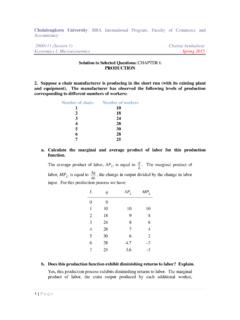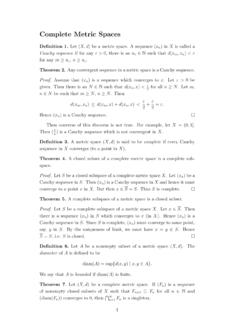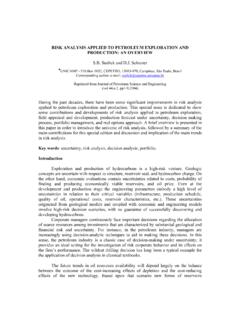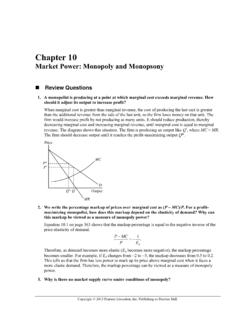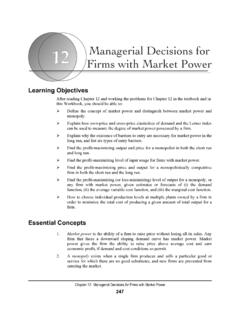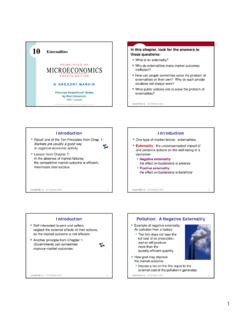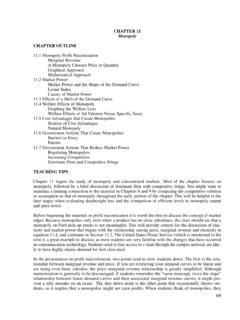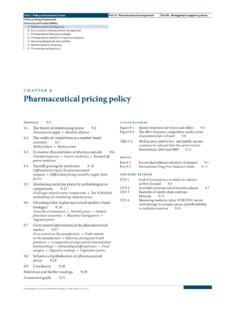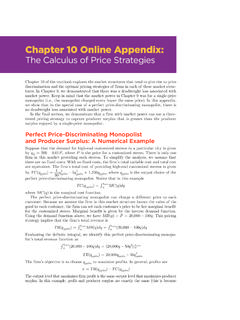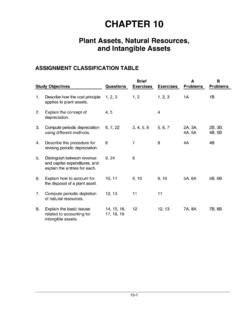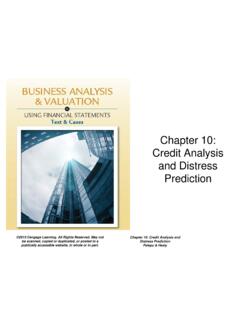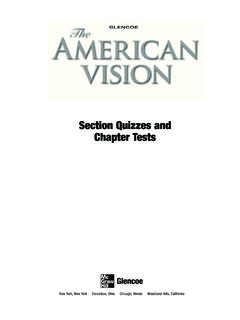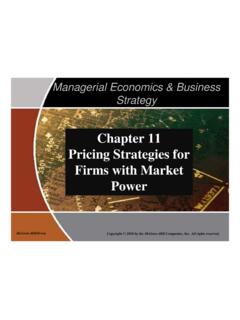Transcription of Solution to Selected Questions: CHAPTER 10 …
1 1 Chulalongkorn University: BBA International Program, Faculty of Commerce and Accountancy 2900111 (Section 1) Chairat Aemkulwat Economics I: Microeconomics Spring 2015 Solution to Selected Questions: CHAPTER 10 market power : MONOPOLY AND MONOPSONY 2. Caterpillar Tractor, one of the largest producers of farm machinery in the world, has hired you to advise it on pricing policy. One of the things the company would like to know is how much a 5-percent increase in price is likely to reduce sales. What would you need to know to help the company with this problem? Explain why these facts are important.
2 As a large producer of farm equipment, Caterpillar Tractor has some market power and should consider the entire demand curve when choosing prices for its products. As their advisor, you should focus on the determination of the elasticity of demand for the company s tractors. There are at least four important factors to be considered. First, how similar are the products offered by Caterpillar s competitors? If they are close substitutes, a small increase in price could induce customers to switch to the competition. Second, how will Caterpillar s competitors respond to a price increase? If the other firms are likely to match Caterpillar s increase, Caterpillar s sales will not fall nearly as much as they would were the other firms not to match the price increase.
3 Third, what is the age of the existing stock of tractors? With an older population of tractors, farmers will want to replace their aging stock, and their demands will be less elastic. In this case, a 5 percent price increase induces a smaller drop in sales than would occur with a younger stock of tractors that are not in need of replacement. Finally, because farm tractors are a capital input in agricultural production, what is the expected profitability of the agricultural sector? If farm incomes are expected to fall, an increase in tractor prices would cause a greater decline in sales than would occur if farm incomes were high.
4 4. A firm faces the following average revenue (demand) curve: P = 120 where Q is weekly production and P is price, measured in cents per unit. The firm s cost function is given by C = 60Q + 25,000. Assume that the firm maximizes profits. a. What is the level of production, price, and total profit per week? The profit-maximizing output is found by setting marginal revenue equal to marginal cost. Given a linear demand curve in inverse form, P = 120 , we know that the marginal revenue curve has the same intercept and twice the slope of the demand curve. Thus, the marginal revenue curve for the firm is MR = 120 Marginal cost is the slope of the total cost curve.
5 The slope of TC = 60Q + 25,000 is 60, so MC equals 60. Setting MR = MC to determine the profit-maximizing quantity: 120 = 60, or Q = 1500. 2 Substituting the profit-maximizing quantity into the inverse demand function to determine the price: P = 120 ( )(1500) = 90 cents. Profit equals total revenue minus total cost: = (90)(1500) (25,000 + (60)(1500)), so = 20,000 cents per week, or $200 per week. b. If the government decides to levy a tax of 14 cents per unit on this product, what will be the new level of production, price, and profit? Suppose initially that consumers must pay the tax to the government. Since the total price (including the tax) that consumers would be willing to pay remains unchanged, we know that the demand function is P* + t = 120 , or P* = 120 t, where P* is the price received by the suppliers and t is the tax per unit.
6 Because the tax increases the price of each unit, total revenue for the monopolist decreases by tQ, and marginal revenue, the revenue on each additional unit, decreases by t: MR = 120 t where t = 14 cents. To determine the profit-maximizing level of output with the tax, equate marginal revenue with marginal cost: 120 14 = 60, or Q = 1150 units. Substituting Q into the demand function to determine price: P* = 120 ( )(1150) 14 = 83 cents. Profit is total revenue minus total cost: = (83)(1150) [(60)(1150) + 25,000] = 1450 cents, or $ per week. Note: The price facing the consumer after the imposition of the tax is 83 + 14 = 97 cents.
7 Compared to the 90-cent price before the tax is imposed, consumers and the monopolist each pay 7 cents of the tax. If the monopolist had to pay the tax instead of the consumer, we would arrive at the same result. The monopolist s cost function would then be TC = 60Q + 25,000 + tQ = (60 + t)Q + 25,000. The slope of the cost function is (60 + t), so MC = 60 + t. We set this MC equal to the marginal revenue function from part (a): 120 = 60 + 14, or Q = 1150. Thus, it does not matter who sends the tax payment to the government. The burden of the tax is shared by consumers and the monopolist in exactly the same way.
8 3 7. Suppose a profit-maximizing monopolist is producing 800 units of output and is charging a price of $40 per unit. a. If the elasticity of demand for the product is 2, find the marginal cost of the last unit produced. The monopolist s pricing rule as a function of the elasticity of demand is: dEPMCP1)( or alternatively, MCEPd 11 Plug in 2 for the elasticity and 40 for price, and then solve for MC = $20. b. What is the firm s percentage markup of price over marginal cost? (P MC)/P = (40 20)/40 = , so the mark-up is 50 percent of the price. c. Suppose that the average cost of the last unit produced is $15 and the firm s fixed cost is $2000.
9 Find the firm s profit. Total revenue is price times quantity, or $40(800) = $32,000. Total cost is equal to average cost times quantity, or $15(800) = $12,000. Profit is therefore = $32,000 12,000 = $20,000. Fixed cost is already included in average cost, so we do not use the $2000 fixed cost figure separately. 14. The employment of teaching assistants (TAs) by major universities can be characterized as a monopsony. Suppose the demand for TAs is W = 30,000 125n, where W is the wage (as an annual salary), and n is the number of TAs hired. The supply of TAs is given by W = 1000 + 75n. a. If the university takes advantage of its monopsonist position, how many TAs will it hire?
10 What wage will it pay? The supply curve is equivalent to the average expenditure curve. With a supply curve of W = 1000 + 75n, the total expenditure is Wn = 1000n + 75n2. Taking the derivative of the total expenditure function with respect to the number of TAs, the marginal expenditure curve is ME = 1000 + 150n. As a monopsonist, the university would equate marginal value (demand) with marginal expenditure to determine the number of TAs to hire: 30,000 125n = 1000 + 150n, or n = Substituting n = into the supply curve to determine the wage: 1000 + 75( ) = $ annually. b. If, instead, the university faced an infinite supply of TAs at the annual wage level of $10,000, how many TAs would it hire?

